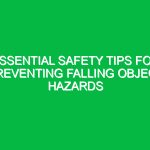Introduction
Personal Protective Equipment (PPE) is a critical component in the Health, Safety, and Environment (HSE) domain. It serves as the first line of defense against various workplace Hazards that can cause injuries or illnesses. Understanding the example of PPE is essential for employers and employees alike, as it not only ensures compliance with Regulations but also fosters a safe working environment. This article will delve into various examples of PPE, their importance, and the regulations that govern their use. By the end of this exploration, readers will have a firm grasp of the essential PPE needed for HSE success.
Understanding the Importance of PPE in HSE
PPE is designed to protect users from Hazards that can lead to serious injuries or health issues. In workplaces such as construction sites, laboratories, healthcare facilities, and manufacturing plants, the risk of exposure to harmful substances or dangerous conditions is significant. The correct use of PPE minimizes these risks, thereby safeguarding the well-being of employees and maintaining a productive work environment.
For instance, a construction worker without proper head protection is at risk of sustaining severe head injuries from falling objects. Similarly, healthcare workers exposed to infectious diseases need PPE to protect themselves and their patients. Therefore, understanding and implementing the appropriate example of PPE is not just a regulatory requirement—it’s a moral obligation.
Key Examples of PPE
Various Types of PPE serve different purposes in protecting workers from specific hazards. Below, we explore essential examples of PPE relevant to the HSE context.
1. Head Protection
Hard hats are a quintessential example of head protection in construction and industrial environments. They are designed to absorb impact from falling objects and provide electrical insulation. Regulations, such as the Occupational Safety and Health Administration (OSHA) standards, mandate the use of hard hats in areas where there is a risk of head injury.
2. Eye and Face Protection
Safety Goggles and face shields protect against chemical splashes, flying debris, and intense light. In laboratories, for instance, wearing goggles is crucial when handling hazardous substances. The American National Standards Institute (ANSI) sets the Standards for eye and face protection, ensuring that these PPE items effectively shield users from potential hazards.
3. Hearing Protection
Noisy environments, such as manufacturing plants, require hearing protection, including earplugs and earmuffs. Prolonged exposure to high-decibel sounds can lead to irreversible hearing loss. osha guidelines specify the use of hearing protection in areas where noise levels exceed permissible limits, emphasizing the importance of this PPE.
4. Respiratory Protection
Respirators are essential in environments with airborne contaminants, such as dust, fumes, or pathogens. For example, during the COVID-19 pandemic, the use of N95 respirators became critical for healthcare workers. The National Institute for Occupational Safety and Health (NIOSH) provides guidelines for effective respiratory protection, ensuring that workers are safeguarded against harmful inhalants.
5. Hand Protection
Gloves are a fundamental example of hand protection, designed to shield the hands from chemicals, cuts, and abrasions. Different materials are used based on the hazards present—latex gloves for medical applications, rubber gloves for chemical handling, and cut-resistant gloves for construction work. Understanding the specific risks associated with tasks is crucial in selecting the right type of gloves.
6. Foot Protection
Steel-toed boots are essential in many industrial settings, providing protection against heavy objects and Electrical Hazards. The American Society for Testing and Materials (ASTM) outlines the standards for protective footwear, ensuring that they meet Safety specifications. Wearing appropriate footwear not only protects against injuries but also enhances overall comfort during long working hours.
7. Body Protection
Coveralls and aprons are examples of body protection that shield workers from hazardous substances, hot materials, or sharp edges. For instance, in the chemical industry, workers often wear chemical-resistant coveralls to prevent skin exposure to corrosive substances. The selection of appropriate body protection is critical in mitigating risks associated with specific tasks.
Best Practices for PPE Usage
To maximize the effectiveness of PPE, organizations must adhere to Best Practices. Here are some essential guidelines:
- Conduct a Hazard Assessment: Before selecting PPE, it is crucial to identify the hazards present in the workplace. A thorough hazard assessment will help determine the appropriate type of PPE needed.
- Provide Training: Employees must receive training on the proper use, maintenance, and limitations of PPE. Regular training sessions keep safety at the forefront and ensure compliance with HSE regulations.
- Regular Inspections: PPE should be regularly inspected for wear and tear. Damaged equipment should be replaced immediately to maintain safety standards.
- Encourage Proper Usage: Employers should foster a culture that emphasizes the importance of wearing PPE. This can be achieved through reminders, visible signage, and regular safety meetings.
Regulations and Standards Governing PPE
PPE is heavily regulated to ensure its effectiveness in protecting workers. Various organizations set standards that govern the use of PPE:
OSHA Standards
The Occupational Safety and Health Administration (OSHA) outlines specific regulations regarding the provision and use of PPE in the workplace. Employers are required to assess workplace hazards and provide appropriate PPE to employees. Failure to comply with OSHA standards can result in penalties and increased risk of accidents.
ANSI Standards
The American National Standards Institute (ANSI) establishes criteria for various types of PPE, including eye and face protection, hearing protection, and head protection. Compliance with ANSI standards ensures that PPE meets performance and testing requirements, providing reliable protection for users.
NIOSH Recommendations
The National Institute for Occupational Safety and Health (NIOSH) provides guidelines for selecting and using respiratory protection. NIOSH certification is essential for respirators to ensure they provide the necessary protection against specific airborne hazards.
Real-life Examples of PPE in Action
To illustrate the importance of PPE, consider the case of a manufacturing facility where employees were found not wearing proper protective gear. This led to multiple incidents of injuries, including chemical Burns and hearing loss. In response, the management implemented a comprehensive PPE program that included training, regular inspections, and strict enforcement of PPE usage policies. Over time, the facility saw a significant decrease in workplace injuries, showcasing the effectiveness of proper PPE implementation.
Conclusion
In conclusion, the example of PPE is vital in promoting health, safety, and environmental success across various industries. By understanding the different types of PPE, adhering to Best Practices, and complying with regulations, organizations can create a safer workplace. The responsibility of ensuring safety falls on both employers and employees, and fostering a culture of safety can lead to significant improvements in overall Workplace Health. As we move forward, it’s essential to remain vigilant about the importance of PPE and continuously educate ourselves about new developments and best practices in the HSE domain.


